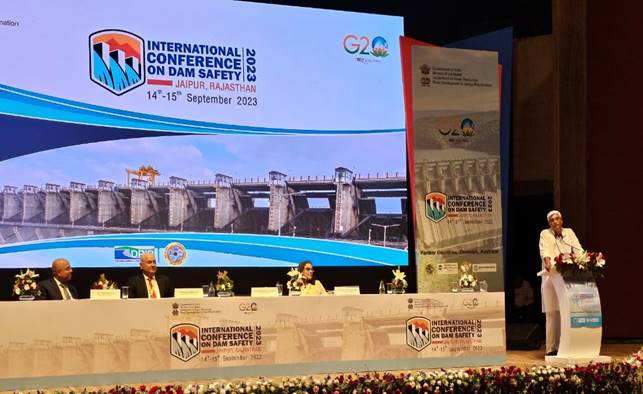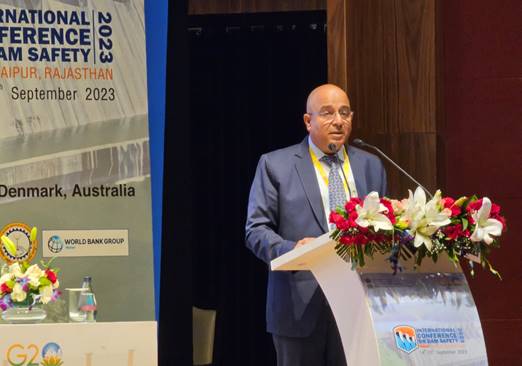International Conference on Dam Safety Organised by Ministry of Jal Shakti Concludes at RIC, Jaipur
The International Conference on Dam Safety (ICDS) organised by the Department of Water Resources, River Development & Ganga Rejuvenation, Ministry of Jal Shakti has concluded at Rajasthan International Centre (RIC) in Jaipur. The closing session of the conference was chaired by the Union Minister of Jal Shakti, Shri Gajendra Singh Shekhawat. Addressing the august gathering, the Union Minister laid emphasis on the issue of dam health and safety which is likely to be a significant feature of the dam management in future. The Union Minister thanked all the participants and expressed confidence that the outcomes of the ICDS 2023 would go a long way for ensuring Dam safety and longevity of the critical dam infrastructure.
The Union Minister for Jal Shakti suggested key actionable points including setting up of a joint action force to take forward the Emergency Action Plans (EAPs) for dams with National Institute of Disaster Management (NIDM); creation of a compendium after analysis of the lacunae that have emerged during construction design as per the Dam Safety Reviews; chalking out a complete strategy integrating the deliberations and outcomes of the conference for its implementation. The Union Minister also recommended organising workshop to discuss the various dam Safety incidents and failures and its outcomes should be disseminated to all the dam owning agencies and other concerned stakeholders to avoid recurrence of such incidents.

Various technical sessions were organised during the two-day conference to enable foremost experts and leaders in the field to strengthen capacities for enhancing dam safety. Joint Secretary, DoWR, RD & GR, Shri Anand Mohan summarized the outcomes of the conference and shared the recommendations that emerged from the sessions during the 2-day conference.

Various presentations were made during the plenary session starting with the sharing of Government of India Initiatives on Dam Safety and Management, followed by other presentations covering the topics of the Dam Safety Status of Maharashtra; Regulating Dam Safety within the Australian State of New South Wales (NSW) sharing valuable experiences from Australia; Collaboration between Denmark & India on Water Management elaborating on the various collaboration efforts between the two nations; Collaboration between Australia & India on Water Management highlighting bilateral cooperation in water management; and World Bank Initiatives on Dam Management providing insights into the World Bank’s initiatives in the field.
The second half of the day began with a technical session on “International & National Practices in Dam Safety Management & Governance” with presentations on Introduction to Dam Safety in USA with an overview of dam safety in the United States; NSW Dams Safety Regulation Framework with insights into the regulation framework in New South Wales; Best Practices for Dam Safety Management; Opportunities Galore for Stakeholders in compliance with the Dam Safety Act, 2021; and Dam Safety Management Practices at Tehri Dam.
The industrial session held concurrently focused on “Dam Health Assessment” and covered a range of topics including Automated Detection and Estimation of Dam Volume of Reservoirs and Dam Bodies using satellite images in Nigeria; Bridging Technology and Safety; Harnessing the Power of Geophysics for dam health assessment; Identification of Weak Zones, a case study on identifying weak zones using seismic tomography; Advancing Dam Safety through Potential Failure Mode highlighting instrumentation for dam safety; Dam Safety and Health Assessment Practices in NHPC; and Seismic Tomography at Baglihar Dam.
On September 15, 2023, the second day of the conference started with technical session which focused on case studies on the Best practices on Dam Rehabilitation. The topics included Dam Rehabilitation Initiatives and Dam Safety Best Practice Note of World Bank; Underwater Pointing and Grouting of 100-Year-Old Krishnarajasagar Dam; Curtain Grouting & Cut-Off Trench along U/S Right Bank of Joshiyara Barrage; Best Practices on Dam Rehabilitation and Improvement Project; and Seepage Control Measures using Cementitious Grouting of Masonry Gravity Dams.
In parallel, another technical session addressed issues on Reservoir Sediment Management; Knowledge Products in Support of Sediment Management Analyses; Holistic Sediment Management in Reservoirs; Damodar Valley Corporation – A Pioneer in Reservoir Sediment Management; Sediment Management Practices in Dhauliganga Power Station; Satellite-Derived Bathymetry Using Sentinel-2 MSI Satellite Data for inland water bodies; Sedimentation In Reservoirs: A Case Study of Bisalpur Dam, Rajasthan; and International Centre of Excellence for Dams (ICED) – Framework and Opportunities.
In the second half of the day, Technical Session focused on “Operation, Maintenance & Emergency Management.” This session addressed critical operational and maintenance aspects covering topics on Optimizing Dam Operation & Maintenance in New South Wales; Reservoir Operational Guidance Based on Optimization Techniques; Performance Evaluation of the Operational Inflow Forecasting System for the Tehri Dam; Bridging The Emergency Management Domain with insights into AIoT technologies for dam emergency prediction, Importance of Glacial Lake Outburst Flood (GLOF) Study: A Case Study in Chenab Basin; and Dredging System for Reservoir.
Concurrently, another Technical Session highlighted “Lessons from Dam Failures & Dam Incidents” covering topics on Liquefaction Analysis of Chang Dam; Failure of Karam Dam; Dam break Analysis of Annamayya Dam across Cheyyeru River, Andhra Pradesh; Geotechnical Investigation of Sink Holesformed on the earthen embankment of Anaikuttam Dam; Seismicity and Dams- A Summary of Performance of Dams During Earthquakes; and A Case Study of Parambikulam Dam Shutter Failure and Management
The following technical session addressed the “Risk Assessment” aspect of dam safety and risk management. The topics included Beyond Standards to a Risk Informed Approach for Dam Safety- Lessons from the United States; Integrated Risk Management; Risk Assessment framework for Indian Dams; Comprehensive Risk Assessment of Maithon Dam; Seismic Safety Assessment of Sholayar Dam Tamil Nadu; Basics of Earthquake Risk Estimation of Dams; Importance of Sensitivity Analysis in PMF Estimate of Large Catchments – A Case Study of Sardar Sarovar Project; The session highlighted the latest methodologies and insights in risk assessment, emphasizing a proactive approach to ensure the safety and integrity of dams. These presentations showcased global perspectives and innovative strategies for addressing dam safety challenges.
In the Industrial session on the topic ‘Dam rehabilitation technique and material’, experts shared groundbreaking insights and advancements in dam rehabilitation. The various topics covered were Laboratory Studies for Design of Suitable Cementitious Grout Mix towards Reducing Seepage in Masonry Dams; Underwater Repair and Rehabilitation of Dam; Efficient Design and Usage of Synthetic Geomembrane For Waterproofing in dams to restore Water Tightness and increase Service Life of the structure; a Case Study on Rehabilitation of Sardar Sarovar Dam with Sika System by CWC Guidelines for Rehabilitation of Large Dams; Assessment of Repair Materials for Repairing Damaged Spillways; Some Dam Safety Aspects- Sediment and Floating Materials Management; and Keep A Close Eye on Your Dams’ Health and Safety.

